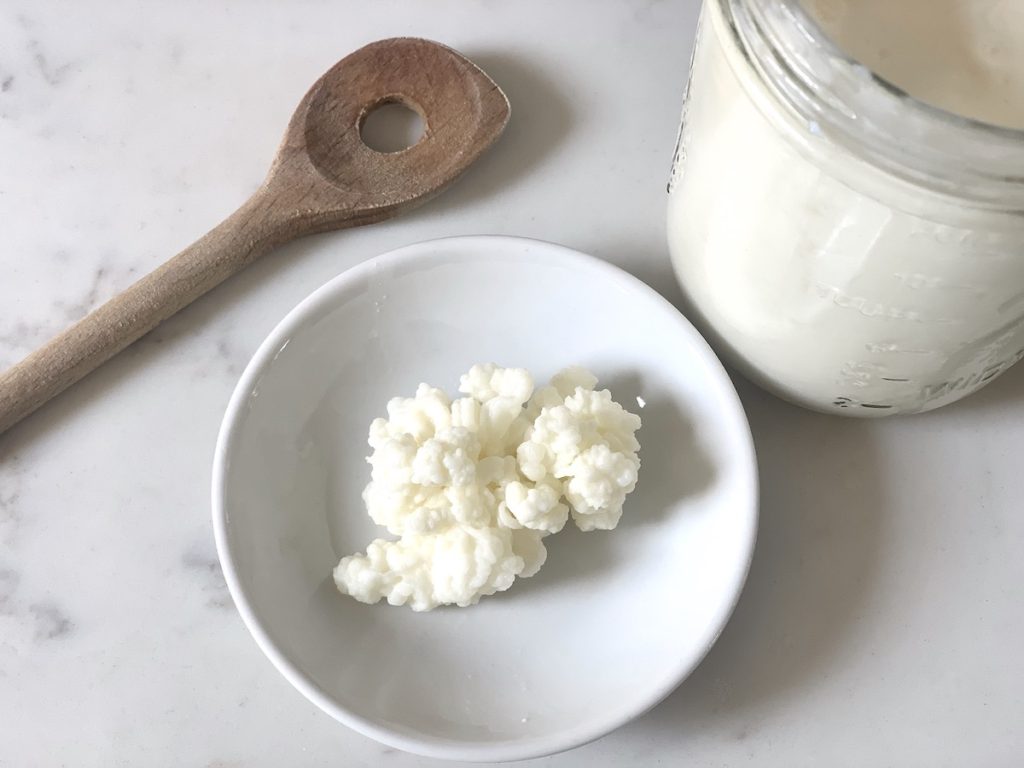How to Slow Down Your Kefir
Learn how you can easily slow down your kefir with this simple method. You will enjoy a new batch every 3 days.
If you have been making it for a while you might wonder how you could slow down your kefir?
A lot of people are a bit frustrated by the amount of kefir you produce every day and ultimately give up on making kefir at home.
Let me show you my very simple method to slow down your kefir production. No freezing or drying involved!
What you need to make kefir
You will need a non-reactive (non-metal) container for your kefir. I love using glass mason jars and currently use the pint-size.
I don’t like using a lid since I want some airflow. Therefore, I use a linen beeswax wrap that I secure with a rubber band.
Obviously, you will need some kefir grains. You might already have some. Otherwise, they are very easy to come by (I’ll list some sources below).
And you need milk.
That’s really all you need to make delicious batches of this probiotic goodness.

About cleanliness
Kefir is very sturdy and forgiving.
While many dairy products need a sterile environment, kefir does not. However, you do want to use clean tools and equipment but you do not need to sterilize your containers or utensils.
I think that because there are so many strains of good bacteria in kefir that they out-compete the bad guys.
Kefir has been around for at least 1000 years if not more and back then, they didn’t know about sterilization nor did they have the means to do that.
What is the best milk for kefir?
Again, kefir is not picky.
That also applies to the type of milk you can use.
Here at our gabled home, we drink raw milk. Of course, that is a personal choice. We do like the taste of raw milk kefir.
But you can make kefir with pasteurized milk, with homogenized milk, with cow’s milk, goat’s milk, and sheep’s milk. Obviously, their taste will be slightly different.
Where to get kefir grains?
Happy kefir grains multiply fast. Very fast. If you have been making kefir, you know that.
That also means that anyone who makes kefir on a regular basis has kefir grains to share.
If you do not have any kefir grains, you could just ask around in your circle of friends. Depending on your neighborhood and area, you might find some on neighborhood networks.
And there are many online places that sell kefir grains. Amazon carries them, Cultures for Health, or Etsy, just to name a few.
Depending on what type of milk you plan on using, it is recommended that you use kefir grains specific to that type of milk. In other words, if you’re planning on using raw milk, you should obtain raw milk kefir grains and so on. You can also “re-train” them (read more about that here).

What if kefir has a yeasty taste?
This happened to me early on. I had obtained freeze-dried kefir grains from a very reputable source with great customer service. I did everything exactly how I was supposed to. After a few batches, my kefir should have been good. However, it had a strong yeast flavor that I didn’t care for. With their customer service, I tried to troubleshoot (varying temperatures, length of fermentation, etc) but still couldn’t get the yeast taste out of my kefir.
I gave up for a while but then tried to get kefir grains from a different source. Those came in a small ziplock bag with a bit of milk. And they produced great-tasting kefir right from the second batch! I am still using them today. They may even taste better now than when I first got them.
Where to ferment your kefir?
While yogurt needs a specific and small temperature range, kefir again is not picky at all. Usually, room temperature is all you need. That can range from 65˚ – 85˚ F. Cooler temperatures will help slow down your kefir while warmer temperatures make your kefir ferment faster. In that case, it might also be more sour and firm.
I let my kefir ferment in a corner of my kitchen. But since I have all sorts of ferments going at various times, I make sure to have a least a few feet between my sourdough, my veggie ferments (sauerkraut), and my kefir so that the bacteria don’t cross over.
With this post, I am encouraging you to experiment with your kefir and get to know it!

What to do with excess kefir grains?
Once you are successfully making kefir, you will notice how fast the grains multiply. If you’re using to many grains per your batch, it will ferment faster. Therefore, it’s a good idea to separate them every so often.
Now what to do with the excess kefir grains?
You can give them to your friends or try to sell them. Or you could put them in your smoothie before you mix it in your blender. I have heard that people eat them, too. I just don’t like their chewy texture. You can dry them or freeze them to have some more if you need them for any reason.
Pets like them (our dog loves eating them!).
Some people add them to their compost.
As you can see, there are many good alternatives to just throwing excess kefir grains in the trash.
How to slow down your kefir production
Since I am currently the only one in our family consuming kefir, I am only using a pint-size mason jar.
To that, I add somewhere between 1 teaspoon and 1 tablespoon of kefir grains.
Next, I fill the jar with milk and put a linen beeswax wrap on top that I secure with a rubber band. Then, I put this jar in the refrigerator for about 24 hours! This helps slow down the kefir.
After 24 hours, I take the jar out and place it on the counter in a quiet corner in my kitchen, leaving it there for another 24 hours.
And to slow it down even further, I put the jar with the already fermented kefir and the grains back in the fridge.
With this method, I am getting a new batch every 3 days. You can switch it up and only place the jar in the fridge only once giving you a new batch every 2 days.
I have to say that I have not experimented with slowing kefir down further to get a new batch every 4 days. Maybe I will try that and report back to you.
Hopefully, I have been able to encourage you to experiment with your ferments. In the same way, that I believe I can “train” my sourdough starter and make it work for my schedule, I have “trained” my kefir grains to do the same.
Happy kefir-making!

Shop this post:
Wide mouth mason jars, 32 oz: https://amzn.to/3bfSew1
Wide mouth mason jars, 16 oz: https://amzn.to/2ELMX3z
Mason jar pour-top: https://amzn.to/2DgyuMl
Kefir grains on amazon: amzn.to/3lDvScE
Kefir grains at Cultures for Health: https://shop.culturesforhealth.com/products/milk-kefir-grains
Kefir grains on Etsy: https://www.etsy.com/listing/566549862/milk-kefir-grains-from-organic-raw-milk?ref=yr_purchases
Let me know if you have any questions or comments!
Pin For Later:



I am still new to drinking Kefir, but my husband grew up drinking it in Ukraine. I don’t know if I’m brave enough to make it myself yet, but this is helpful information to know!
Thanks for sharing this post with us on the Embracing Home and Family Link-up party. We hope you join us again this Friday!
-Cherelle
Yes, you should try it! It’s so good. If you like I can send you some of my grains next time I am ready to divide them up. Just say the word 😊
I had no idea kefir could be slowed down like this! I was the only person in my home drinking kefir too and it got to be a lot … I’ll have to try it again now that I have learned these great tips!
Yes, do it! You’ll find it so simple and easy. Let me know how it’s working out when you get your kefir grains!
Great post & tutorial. I have never made kefir. Looks easy to do.
Thank you so much, Dusty! It actually is very easy to do!